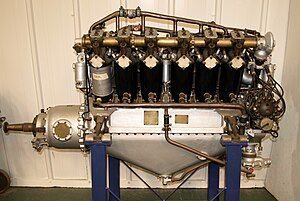Rolls-Royce Falcon
| Falcon | |
|---|---|
 | |
| Preserved Rolls-Royce Falcon III at the Shuttleworth Collection | |
| Type | V-12 aero engine |
| Manufacturer | Rolls-Royce Limited |
| First run | 1915 |
Major applications | Bristol F.2 Fighter Blackburn Kangaroo |
Number built | 2,185 |
Unit cost | £1,210 (1918) |
Developed from | Rolls-Royce Eagle |
The Rolls-Royce Falcon is an aero engine developed in 1915. It was a smaller version of the Rolls-Royce Eagle, a liquid-cooled V-12 of 867 cu in (14.2 L) capacity. Fitted to many British World War I-era aircraft, production ceased in 1927. The Falcon was designed by R.W. Harvey-Bailey.[1]
An airworthy Falcon survives today and powers a Bristol F.2 Fighter during summer displays.
Contents
1 Design and development
2 Variants
3 Applications
4 Survivors
5 Engines on display
6 Specifications (Falcon III)
6.1 General characteristics
6.2 Components
6.3 Performance
7 See also
8 References
8.1 Notes
8.2 Bibliography
9 External links
Design and development
Production of the Falcon began in September 1916 and was so successful that it was also manufactured under licence by Brazil Straker in Bristol.[2] Production continued until 1927, by which time 2,185 had been built.[3]
An unusual feature of this engine was the epicyclic propeller reduction gear which contained a clutch designed to limit the maximum torque, thus protecting the reduction gears.[4]
The Falcon was notably used in the Bristol F.2 Fighter and Blackburn Kangaroo bomber.
Variants
Note:[5]
- Falcon I (Rolls-Royce 190 hp Mk I)
- (1916-17), 230 hp, 250 engines produced in both left- and right-hand tractor versions.
- Falcon II (Rolls-Royce 190 hp Mk II)
- (1917), 253 hp, carburettor size increased. 250 built at Derby.
- Falcon III (Rolls-Royce 190 hp Mk III)
- (1917-1927), 285 hp, increased compression ratio (5.3:1), twin carburettors replaced with four Rolls-Royce/Claudel-Hobson units. 1,685 built at Derby.
Applications
List from Guttery and Lumsden:[3][4]
- Armstrong Whitworth F.K.12
- Avro 523C Pike
- Avro 529
- Blackburn G.P. Seaplane
- Blackburn Kangaroo
- Blackburn Sprat
- Bristol Type 12 F.2A
- Bristol Type 27 F.2B Coupe
- Bristol F.2 Fighter
- Bristol Type 86 Greek Tourer
- Bristol Type 96
- Curtiss H-12
- de Havilland DH.37
- Fairey F.2
- Fairey N.9
- Martinsyde F.3
- Martinsyde R.G
- Martinsyde Buzzard
- Parnall Perch
- Royal Aircraft Factory F.E.2
- Royal Aircraft Factory R.E.7
- Vickers F.B.14
- Vickers Viking
- Vickers Vendace
- Vickers Vedette
- Westland Limousine
- Westland Wizard
Survivors
Bristol F.2B Fighter, D-8096, is based at the Shuttleworth Collection and is powered by a Falcon III, this aircraft flies regularly throughout the summer months.[6]
Engines on display
- A Rolls-Royce Falcon is on public display at the Shuttleworth Collection, Bedfordshire.
Specifications (Falcon III)

Data from Jane's[7] and Lumsden.[3]
General characteristics
Type: 12-cylinder liquid-cooled 60 deg. Vee aircraft piston engine
Bore: 4 in (101.6 mm)
Stroke: 5.75 in (146 mm)
Displacement: 866.5 in³ (14.2 L)
Length: 68 in (1,727 mm)
Width: 40.3 in (1,024 mm)
Height: 37.2 in (945 mm)
Dry weight: 715 lb (324 kg)
Components
Valvetrain: Overhead camshaft, two valves per cylinder
Fuel system: Four Rolls-Royce/Claudel-Hobson carburettors
Fuel type: 40-50 octane petrol (pre-1923)
Cooling system: Liquid-cooled
Performance
Power output: 288 hp (215 kW) at 2,300 rpm at sea level
Compression ratio: 5.3:1
Fuel consumption: 18.5 Imp gal/hr (84 L/hr)
Oil consumption: 0.75 Imp gal/hr (3.4 L/hr)
Power-to-weight ratio: 0.4 hp/lb (0.66 kW/kg)
See also
- Rolls-Royce aircraft piston engines
Related development
- Rolls-Royce Eagle
Related lists
- List of aircraft engines
References
Notes
^ "World Encyclopedia of Aero Engines - 5th edition" by Bill Gunston, Sutton Publishing, 2006, p.185
^ Pugh 2001, p.82.
^ abc Lumsden 2003, p.188.
^ ab Guttery 1969, p.27.
^ Alternate designations in italics.
^ Shuttleworth Collection - Bristol Fighter www.shuttleworth.org. Retrieved: 13 December 2017
^ Jane's 1989, p.312.
Bibliography
.mw-parser-output .refbegin{font-size:90%;margin-bottom:0.5em}.mw-parser-output .refbegin-hanging-indents>ul{list-style-type:none;margin-left:0}.mw-parser-output .refbegin-hanging-indents>ul>li,.mw-parser-output .refbegin-hanging-indents>dl>dd{margin-left:0;padding-left:3.2em;text-indent:-3.2em;list-style:none}.mw-parser-output .refbegin-100{font-size:100%}
- Guttery, T.E. The Shuttleworth Collection. London: Wm. Carling & Co, 1969. .mw-parser-output cite.citation{font-style:inherit}.mw-parser-output .citation q{quotes:"""""""'""'"}.mw-parser-output .citation .cs1-lock-free a{background:url("//upload.wikimedia.org/wikipedia/commons/thumb/6/65/Lock-green.svg/9px-Lock-green.svg.png")no-repeat;background-position:right .1em center}.mw-parser-output .citation .cs1-lock-limited a,.mw-parser-output .citation .cs1-lock-registration a{background:url("//upload.wikimedia.org/wikipedia/commons/thumb/d/d6/Lock-gray-alt-2.svg/9px-Lock-gray-alt-2.svg.png")no-repeat;background-position:right .1em center}.mw-parser-output .citation .cs1-lock-subscription a{background:url("//upload.wikimedia.org/wikipedia/commons/thumb/a/aa/Lock-red-alt-2.svg/9px-Lock-red-alt-2.svg.png")no-repeat;background-position:right .1em center}.mw-parser-output .cs1-subscription,.mw-parser-output .cs1-registration{color:#555}.mw-parser-output .cs1-subscription span,.mw-parser-output .cs1-registration span{border-bottom:1px dotted;cursor:help}.mw-parser-output .cs1-ws-icon a{background:url("//upload.wikimedia.org/wikipedia/commons/thumb/4/4c/Wikisource-logo.svg/12px-Wikisource-logo.svg.png")no-repeat;background-position:right .1em center}.mw-parser-output code.cs1-code{color:inherit;background:inherit;border:inherit;padding:inherit}.mw-parser-output .cs1-hidden-error{display:none;font-size:100%}.mw-parser-output .cs1-visible-error{font-size:100%}.mw-parser-output .cs1-maint{display:none;color:#33aa33;margin-left:0.3em}.mw-parser-output .cs1-subscription,.mw-parser-output .cs1-registration,.mw-parser-output .cs1-format{font-size:95%}.mw-parser-output .cs1-kern-left,.mw-parser-output .cs1-kern-wl-left{padding-left:0.2em}.mw-parser-output .cs1-kern-right,.mw-parser-output .cs1-kern-wl-right{padding-right:0.2em}
ISBN 0-901319-01-5
Jane's Fighting Aircraft of World War I. London. Studio Editions Ltd, 1993.
ISBN 1-85170-347-0
- Lumsden, Alec. British Piston Engines and their Aircraft. Marlborough, Wiltshire: Airlife Publishing, 2003.
ISBN 1-85310-294-6. - Pugh, Peter. The Magic of a Name - The Rolls-Royce Story: The First 40 Years. Duxford, Cambridge: Icon Books, 2001.
ISBN 1-84046-151-9.
External links
| Wikimedia Commons has media related to Rolls-Royce Falcon. |
- Photo of a Rolls-Royce Falcon at enginehistory.org